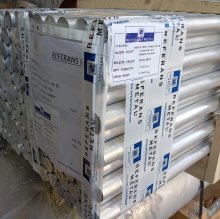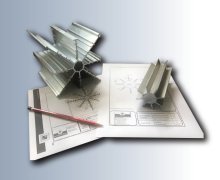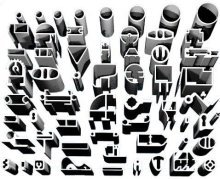



Platten
Blech
Rundstangen
Rohre/ Extrusion/ Profil
2033
ASTM B221 / AW-2033 / 2033 / T6
| Chemical Properties | % Value |
| Silicon (Si) | 0,10 - 1,20 |
| Chromium (Cr) | 0,00 - 0,15 |
| Manganese (Mn) | 0,40 - 1,00 |
| Magnesium (Mg) | 0,20 - 0,60 |
| Copper (Cu) | 2,20 - 2,70 |
| Titanium (Ti) | 0,00 - 0,10 |
| Iron (Fe) | 0,00 - 0,70 |
| Zinc (Zn) | 0,00 - 0,50 |
| Aluminium (Al) | Balance |
| Physical Properties | Value |
| Density | 2.77 g/cm³ |
| Melting Point | 502 °C |
| Thermal Expansion | 22.9 µm/m.°C |
| Modulus of Elasticity | 70 GPa |
| Thermal Conductivity | 162 W/m.K |
| Electrical Resistivity | 0.046 Ωmm² /m |
| Mechanical Properties | Value |
| Proof Strength | 260 MPa |
| Yield Strength | 370 MPa |
| Shear Strength | 283 MPa |
| Elongation A50 mm | 8% |
| Hardness | 95 HB |
The 2033 T6 aluminum alloy is known for its high mechanical strength, good machinability, and excellent corrosion resistance. The T6 temper, achieved through heat treatment, provides the alloy with high hardness and durability. These properties make 2033 T6 an ideal choice for structural applications in industries such as aerospace, defense, and other high-performance sectors. Additionally, 2033 T6 is suitable for anodizing, which enhances its surface appearance while increasing corrosion resistance.
In terms of weldability, 2033 T6 aluminum alloy can be welded successfully with the proper techniques. However, its high hardness and strength require careful attention during the welding process. When it comes to bending, 2033 T6 is more difficult to bend compared to more flexible alloys due to its high hardness and durability. Nevertheless, it can still be shaped with the right equipment and techniques, but extra care is required during the bending process.
The corrosion resistance of 2033 T6 is excellent under atmospheric conditions and provides sufficient resistance in harsh environments such as seawater. This makes it ideal for applications in maritime and outdoor structures. Additionally, 2033 T6 is suitable for use in high-vibration environments, making it advantageous for dynamic industries such as automotive, aerospace, and defense.
The advantages of 2033 T6 aluminum alloy include high mechanical strength, corrosion resistance, anodizing compatibility, weldability, and suitability for high-vibration environments. However, its high hardness and strength can create challenges during welding and bending processes. Additionally, this alloy may not be as easy to machine as more flexible alloys. Despite these challenges, 2033 T6 is an excellent choice for industrial applications requiring high performance and durability.
ALLOY DESIGNATIONS
Aluminium alloy 2033 T6 has similarities to the following standard designations and specifications:
Extruded Drawn Round/Flat Bars and Tubes per; 2033 T6, 2000/53/EU (ELV) - 2018/740/EU (RoHS II), UNS A92033, ASTM B221
Choosing Factors for 2033 T6
- Strength: Very good
- Machining: Exquisite
- Weldability: Medium
- Formability: Fair
- Corrosion Resistance: Poor
- Heat Treating: Yes
Some Well-Known Applications for 2033 T6
Precision turned and machined parts,
Fasteners in the automotive industry,
As components of ammunition in the defense industry.
SUPPLIED FORMS
2033 T6 is supplied in round/flat bar and tube/ profile forms.
- Flat/round bar
- Tube/profile
| Mechanical Properties | |||
| Thickness (mm) | Proof Strength (Min.) | Yield Strength (Min.) | Elongation A50 mm % |
| Up to & incl. 80 mm | 250 MPa | 370 MPa | 8% |
| Over 80 up to & incl. 250 mm | 220 MPa | 340 MPa | 8% |

 Gewichts-Kalkulator
Gewichts-Kalkulator

